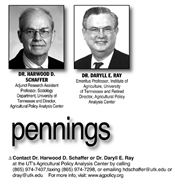|
African Swine Fever Hits China And Could Impact Hog And Soybean Markets Worldwide

In the midst of the ongoing US trade dispute with China, the spread of African swine fever (ASF) in the Chinese hog herd has the potential to further depress US soybean prices. The extent of the price impact will likely depend upon the degree to which Chinese authorities can control the spread of the disease. The spread of the disease may also have a negative on other soybean exporters who have enjoyed a soybean price premium as the result of the retaliatory tariffs China has placed on the imports of US soybeans.
The first reports of the appearance of the nearly universally fatal disease in China were received in August 2018. As of the writing of this column, journalists have reported on the appearance of the disease in various parts of the country, but the type of government disease reporting and surveillance we experienced with the 2015 outbreak of avian influenza in the US poultry flock is not present in China. The Swine Health Information Center (SHIC) in the US (https://tinyurl.com/y5fpx5t2) provides regular monitoring reports of swine diseases including ASF. Additional information can be found on the World Organization for Animal Health (OIE) website (https://tinyurl.com/y6xx8esp).
African swine fever in wild hogs, domestic hogs, and peccaries can be spread from one infected animal to the next. The disease is present in bodily fluids of infected animals and recovered animals and can be spread by blood sucking insects like mosquitos. It is present in butchered meat from infected animals and has been found in Chinese pork destined for export. According to SHIC, “the Australian Department of Agriculture has reported the first cases of ASF detected in products confiscated by authorities at points of entry…. In addition to the findings in Australia, South Korea, Japan, and Taiwan have also reported the identification of ASF in confiscated products at ports of entry since last August.”
At the present time, China is not the only location where the disease is active. In addition to areas on the African continent where it is endemic, it has been found in Vietnam, Taiwan, and Eastern Europe where it has been spread by wild boars. Given the nature of the disease, it will take significant containment mechanisms on the part of authorities worldwide to bring the disease under control.
ASF and the subsequent reduction in pork supplies has driven up pork prices in China which consumes nearly half the pork in the world. If the disease spreads to even a quarter of the Chinese hog herd, the impact will reverberate around the world. World pork prices will rise as China attempts to make up for lost domestic supplies by increasing its imports of pork. Some of the meat demand in China will likely shift to poultry from both domestic and international sources.
Any significant reduction in the production of pork in China, even for a limited period of time (in this case, a year or more), will result in lowered demand for soybeans and soybean meal and lower soybean prices for all farmers and a double whammy for US farmers who are reeling from retaliatory tariffs. Currently, China accounts for nearly 60 percent of world soybean imports so any reduction in Chinese imports will have an immediate impact on price.
It will be interesting to see what impact the ASF-related Chinese pork production problems will have on trade negotiations between China and the US over the next few months. Any promise of reduced soybean tariffs by China may not carry much weight as China reduces its overall soybean imports because it has fewer pigs that need to be fed. At the same time, China may feel more pressure to reduce tariffs on imports of US pork products from its domestic consumers than from US trade negotiators.
In the long-run, the issue that is more important than tariff negotiations for US producers and consumers is the prevention of the arrival of ASF in the Americas. If ASF were to get into the US hog herd and the US feral hog population, the cost could be significant. ∆
DR. HARWOOD D. SCHAFFER: Adjunct Research Assistant Professor, Sociology Department, University of Tennessee and Director, Agricultural Policy Analysis Center
DR. DARYLL E. RAY: Emeritus Professor, Institute of Agriculture, University of Tennessee and Retired Director, Agricultural Policy Analysis Center
|
|